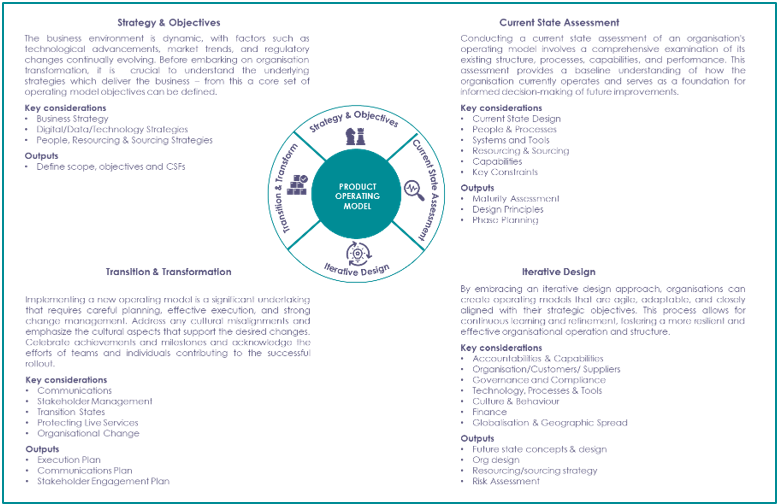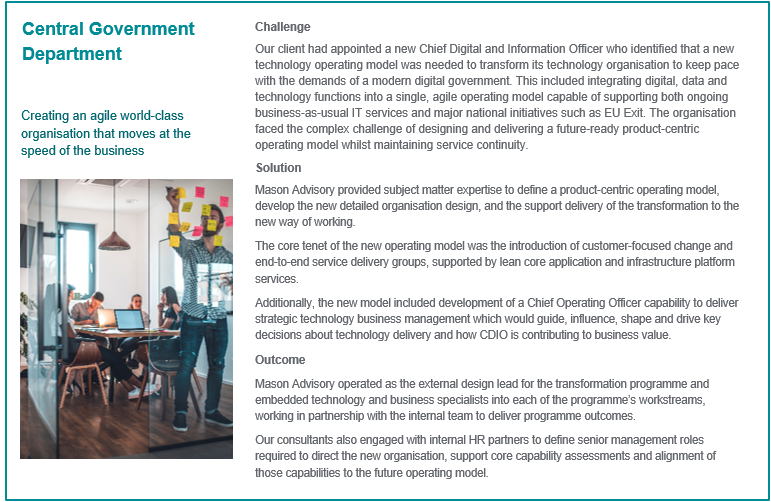Transforming operating models: eight essentials for building a product-centric operating model
Share:
Date:
August 2025

key fact
According to a 2025 study by HCLTech, 88% of enterprises are moving towards product-aligned operating models
In today’s fast-evolving landscape, traditional project-based delivery models often struggle to keep up with market demands. To compete effectively, organisations must embrace product-centric operating models that enable agility, accountability, and innovation by focusing on delivering value through end-to-end ownership of products. This article outlines eight foundational areas critical to successful transformation—built not just to pivot, but to last.
To help organisations achieve this, we’ve identified eight core areas that are critical when designing and implementing a modern operating model.
These eight areas offer a practical blueprint for lasting transformation. With the right strategy, leadership and cultural mindset, organisations can deliver faster, more aligned outcomes —driving real value in a dynamic market.
- Executive leadership: setting the vision: transformation starts at the top. Executive support isn’t optional — it’s essential. Leaders must champion the shift, connect product strategies to business goals, and evolve funding models from short-term projects to long-term product investments. Visionary leadership lays the cultural foundation for success.
- Organisation: scaling capabilities across the enterprise: size matters. Larger organisations face more complexity, which means assessing readiness, identifying skills gaps, and building autonomous, cross-functional product teams is key to success. Smaller organisations may not have the scale to pivot to dedicated product aligned teams.
- Culture & engagement: driving change from within: culture change is often the hardest part. Moving to customer-focussed, outcome-driven thinking demands trust, transparency and psychological safety. Engaging employees early and planning for resistance helps embed lasting transformation.
- Technology: enabling autonomy: technology should empower teams—not hold them back. Cloud platforms, DevOps pipelines and GenAI all play a role in giving teams the tools to innovate and deliver faster — while reducing technical debt and bottlenecks.
- Suppliers: redefining partnerships: vendor relationships need a reset. Suppliers should become strategic partners, integrated into product teams with shared goals. Outcome-based contracts and seamless collaboration unlock the true value of external support.
- Governance that empowers: strong governance shouldn’t stifle progress but should provide clarity. Clear decision-making structures and accountability frameworks enable teams to move fast while staying aligned with organisational risk and compliance needs.
- Accountability: in matrix management models: balancing personal development and delivery accountability requires smart management structures. Matrix models must clarify reporting lines, resolve conflicts efficiently, and support career progression within a product-focused framework.
- Shared functions: elevating as strategic enablers: shared services—like HR, finance, IT infrastructure and data teams — must evolve enable agility. Whether through platform teams, centres of excellence or service design, these functions should act as engines that support product delivery — not barriers to it.
Development of product-centric operating models
Designing a product-centric operating model is a complex undertaking. It requires aligning organisational elements — strategy, structure, people and processes — to achieve clearly defined goals.
Success depends on navigating interconnected components, managing diverse stakeholder perspectives, and adapting to an ever-changing business environment. That’s where experience matters.
At Mason Advisory, we bring a proven strategic approach, supported by robust change management, to help organisations design and embed operating models that unlock performance, agility and long-term value.
Figure 1: Our operating model development methodology
Below is a case study where we helped a central government department define a product-centric operating model that moved at the speed of the business.
Figure 2: Case study
Ready to Begin Your Transformation?
These eight essentials provide a blueprint—but real success is built through sustained commitment, empowered teams, and a culture that embraces change.
Reach out to Chris and our Operating Model experts by sending your enquiry to contact@masonadvisory.com to explore how we can help or click here to learn more about our services.

